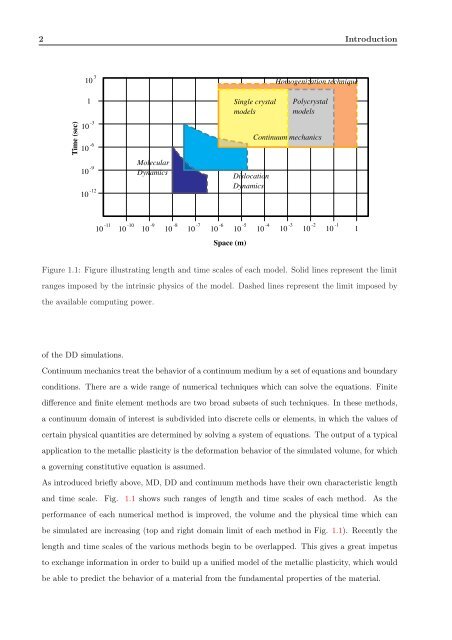3D DISCRETE DISLOCATION DYNAMICS APPLIED TO ... - NUMODIS
3D DISCRETE DISLOCATION DYNAMICS APPLIED TO ... - NUMODIS
3D DISCRETE DISLOCATION DYNAMICS APPLIED TO ... - NUMODIS
You also want an ePaper? Increase the reach of your titles
YUMPU automatically turns print PDFs into web optimized ePapers that Google loves.
2 Introduction<br />
Time (sec)<br />
10 3<br />
1<br />
10 -3<br />
10 -6<br />
10 -9<br />
10 -12<br />
Molecular<br />
Dynamics<br />
10 -11 10 -10 10 -9<br />
10 -8<br />
10 -7<br />
10 -6<br />
Single crystal<br />
models<br />
Dislocation<br />
Dynamics<br />
10 -5<br />
Space (m)<br />
Homogenization technique<br />
Polycrystal<br />
models<br />
Continuum mechanics<br />
Figure 1.1: Figure illustrating length and time scales of each model. Solid lines represent the limit<br />
ranges imposed by the intrinsic physics of the model. Dashed lines represent the limit imposed by<br />
the available computing power.<br />
of the DD simulations.<br />
Continuum mechanics treat the behavior of a continuum medium by a set of equations and boundary<br />
conditions. There are a wide range of numerical techniques which can solve the equations. Finite<br />
difference and finite element methods are two broad subsets of such techniques. In these methods,<br />
a continuum domain of interest is subdivided into discrete cells or elements, in which the values of<br />
certain physical quantities are determined by solving a system of equations. The output of a typical<br />
application to the metallic plasticity is the deformation behavior of the simulated volume, for which<br />
a governing constitutive equation is assumed.<br />
As introduced briefly above, MD, DD and continuum methods have their own characteristic length<br />
and time scale. Fig. 1.1 shows such ranges of length and time scales of each method. As the<br />
performance of each numerical method is improved, the volume and the physical time which can<br />
be simulated are increasing (top and right domain limit of each method in Fig. 1.1). Recently the<br />
length and time scales of the various methods begin to be overlapped. This gives a great impetus<br />
to exchange information in order to build up a unified model of the metallic plasticity, which would<br />
be able to predict the behavior of a material from the fundamental properties of the material.<br />
10 -4<br />
10 -3<br />
10 -2<br />
10 -1<br />
1


